Hello MTGO beginners!
In this tutorial we will examine one of the most popular Magic: The Gathering formats – Drafting. You will learn how the format works, what you have to take into account before you jump into the tournament queues, and how to deal with various issues that can arise during drafting and the games. This piece is aimed at beginners who want to learn how the format works and how to avoid the common pitfalls. I will provide screen shots where useful and show you what the various buttons and stats mean that you will find during the drafting.
But enough introduction, let’s jump right in!
What is Booster Drafting?
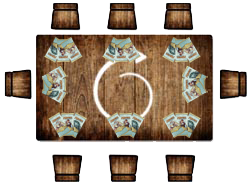 In a Booster Draft players, (usually eight) sit around a table, and each of them has three sealed Booster Packs in front of them. This boosters have to be from a specific set or block, and each player has the same boosters. Now everyone opens the first booster, flips through all the cards in the pack, picks one and only one of the cards, puts it face down in front of him, and hands the rest of the cards to the left neighbor. This means you are going to receive the leftover of your right neighbor’s booster, from which you will again pick one card to add to your pool and hand the rest to your left neighbor. This repeats until all fifteen cards have been distributed this way.
In a Booster Draft players, (usually eight) sit around a table, and each of them has three sealed Booster Packs in front of them. This boosters have to be from a specific set or block, and each player has the same boosters. Now everyone opens the first booster, flips through all the cards in the pack, picks one and only one of the cards, puts it face down in front of him, and hands the rest of the cards to the left neighbor. This means you are going to receive the leftover of your right neighbor’s booster, from which you will again pick one card to add to your pool and hand the rest to your left neighbor. This repeats until all fifteen cards have been distributed this way.
Now you open the second booster and repeat the process but you hand the cards to your right neighbor this time. The third and last pack is again handed to the left until all players have 45 cards in front of them (3x 15 cards). During live events a judge will make sure that all players stay in sync, and that no one is cheating cards into their stacks. He will also limit the time that each player may take for his choice. MTGO will do that automatically and limit the time you can take before it automatically picks a random card for you when your time runs out (without a choice from your side). Please note that you will be able to add as many basic lands as you like to the pool, so you don’t need to worry drafting them at all!
See this video for a live coverage of a top draft tournament (Pro Tour Nagoya):
When you have finished the draft portion, you will use those 45 cards in your pool to build the best possible deck, with which you will then play against the other players to determine the tournament winner. Your deck has to have a minimum size of 40 cards total, including lands but has no upper limit. Why it is still recommended to stay as close as possible to the minimum we will discuss later.
All cards you are not using in your deck become your sideboard, and you are allowed to exchange cards between your sideboard and deck between the games of a match, but you have to start each new match with your initial configuration. All cards that you have drafted will remain yours when the tournament ends, regardless of the outcome of the matches. You might, however, win additional booster packs depending on your result and the type of Booster Draft you have entered.
How does it work on MTGO?
In an MTGO Booster Draft you will enter the tournament via the home screen or the menu/play/tournaments/Limited Queues and play a maximum of three rounds to determine the winner of the tournament. When you enter the tournament center as described, you will see a huge amount of tournaments that are currently in progress or waiting for players. The tournament center will provide the following information for each tournament (see screenshots below):
1. Tournament ID – The tournament ID, or simply ID, of the tournament will be important in case you encounter a bug during the game or the client crashes without a fault from your side. We highly recommend you write down the tournament ID before you enter the tournament, as it can be quite difficult to get ahold of it later and may create difficulties for you when filling out a compensation request.
2. Description – The description will show you what sets or which block will be drafted and the type of tournament you are
entering. Depending on your skill level and risk preference you will have to choose between.
a) 8-4 Drafts: This simply means that you will have to win the first two rounds to receive a price. When you lose a match, you are out of the tournament (single elimination). The loser of the finals receives four booster packs and the winner eight booster packs; the other six players get nothing! This is great, of course, if you have drafted the set a lot and you are a very strong player, but we do not recommend this to beginners at all!
b) 4-3-2-2 Drafts: This simply means that you will have to win the first round to receive a price. The loser of the finals receives three booster packs and the winner four booster packs; the winners of the first round receive two boosters. You will find many different kinds of players in this prize structure and it is less risky but also provides a smaller reward. Usually you will want to play here if you are already well familiar with the format and feel confident in your playing ability.
c) Swiss Drafts: In a Swiss Draft you will play all three rounds regardless of whether you win or lose any round. You will get one booster pack for each of the three rounds you win, and you will get paired against an opponent who has the same win/loss ratio you have, e.g., if you have lost the first round, you will play against someone who also lost his first round. Swiss provides a maximum reward of three booster packs but gives you the opportunity to stay in the tournament regardless of the outcome of the matches. It is a great way to gain experience with a format and with new cards. This is the format we would highly recommend to beginners who feel ready to jump into competitive Limited tournaments.
d) Phantom Drafts: In a Phantom Draft you pay a much lower entry fee but do NOT keep the cards you are drafting. See information about this rather new format here.
3. Status – Is showing you if the tournament is finished, in progress, or if it is waiting for players.
4. # Players – Here you can see how many players are seated at the table. When eight players are present the tournament starts automatically and your first booster will be opened for you.
5. Speed – There are tournaments that allow less time for choosing your card. We recommend you stay with the “Regular” speed, which in most cases is the only option anyway.
6. K-Value – The “K-Value” determines how much your rating can change when playing the tournament. It is not really important precisely how it is calculated at the moment, and it is enough to know that the higher the K-Value, the more important the tournament is for determining rating changes. It shouldn’t really matter for you at this stage.
7. Time Limits – Shows you how much time you will have to build and submit your deck and how long a round will take maximally.
To participate you will have to double click on the tournament and either provide the entry fee, which is usually 2 event tickets AND the three booster packs, or you can pay 14 event tickets if you do not have the booster packs. You can click on the tabs after double clicking to chose between those options. If you already have the booster packs, make sure to pick the “booster + 2 event tickets” option before entering. See below:
When you have entered the tournament, it will start as soon as 8 people are in the Draft. Depending on the time and the format, this can take a while or fill within seconds. Then you will see a screen like this (double click to enlarge):
Once you have picked 45 cards and all the other players have done the same, the screen view will switch to the deck building screen. Here you can use the cards you have drafted to build a 40 card deck you will use to play out the matches versus the other players. All cards that do not end up in your deck build your sideboard and can later be used to make changes between games.
IMPORTANT: All cards you have drafted are permanently yours and you will keep them unless you participate in a “Phantom Event”. Those are far cheaper to enter but you do not keep any of the cards.
See the following picture for an overview of the deckbuilding screen:
When the deckbuilding time runs out, you will be automatically matched with one of the other players in the Draft and play a best of three match. The first person that wins two games advances to the next round. You are free to change your deck between games to adapt to your opponent’s strategy if you have useful sideboard cards. When you are satisfied with the composition of your deck, click on “Submit” and wait for your opponent to do the same. If you lose a match in a 4-3-2-2 or 8-4 Draft, you are out and will have to wait until the event is completely over to receive any prizes you might have won.
If you are playing a Swiss draft you will ALWAYS play all three rounds regardless of the outcome of the previous round.
What else should I know when drafting on MTGO?
To make the experience as positive as possible for you, I have compiled a list of short tricks, advice, and general rules of thumb you can refer to moving forward. I have also collected the most valuable links for you to help you advance your knowledge as well as find resources you might want to use to increase your play skill.
- If you are just starting out and want to test the water, definitively use Swiss Drafts only. Not only are the opponents generally a bit weaker then in the others, but you also have the opportunity to play all 3 rounds no matter what and can get accustomed to the interface and the format.
- While you should focus on picking the best cards for your deck, don’t lose track of the monetary value of the cards in the set you are drafting. If you have a rare/mythic that is worth more then 4 tickets, it is usually a good idea to take it regardless of the play value for you. Selling those cards will help you finance your next Draft entry.
- You will lose the match and be kicked out of the tournament if you don’t show any activity for 10 minutes. Make sure you don’t enter a Draft and then forget about it. Sometimes a Draft is not filling quickly and it takes some time until it starts – trust me, such things happen all the time.
- Always write down the event number, time, and the game number of the game you are just playing. The reason is that in case you encounter a bug in the system or the draft gets canceled outside of your culpability, you will need these numbers to file for compensation. If you do that, you have a great chance to get the packs back you have bought and it is much harder to find those numbers once you are disconnected or the system crashes.
- Make sure that you are not disconnected without noticing. MTGO has no way to notify you once you are disconnected and it might even look as if your opponent’s time is running down! If you notice that your opponent is not reacting for several minutes, chat with him and if there is no reaction, you should close the client and restart it again. MTGO will automatically connect you to your game again. Many players have lost product due to this issue and you don’t have to be one of them!
- Be very much aware of the countdown clock – you only have 25 minutes for a maximum of 3 games and that is not much time. Try to focus on the game and don’t distract yourself with other things while playing. Many players have lost games and matches because they run out of time. To help you definitively learn how to use the shortcuts and F-keys. You can find a tutorial about it here.
- Learn from good players by watching draft videos and listen to their card choices and reasoning during the games. You can find plenty of Draft videos on MTGO Academy from some of the best players online.
- Build a deck that consists of 17 lands and 23 non-lands. Far too many beginners play with too little land in their decks and lose due to mana screw. You should not play with more than 40 cards to increase the chance to find your best spells. If you watch the top players, you will rarely find a deck with more then the minimum allowed number of cards.
- Be prepared for opponents that use the anonymity of the Internet to insult you and the deck you are playing. While most players are nice, some simply do not have the character to lose with dignity. At the same time, be a good winner and a good loser. Bad luck happens and should not be a reason to blame your opponent. It’s not he who is shuffling your deck after all. In any case it is forbidden to engage in abusive behavior on MTGO, and if you encounter an opponent who does not know when to stop, take a screenshot and report him – Wizards is issuing warnings and even bans for repeaters.
- If you have questions during your games, do not hesitate to ask the ORCs (Online Response Crew); they are there to help you and provide you with the information you need to enjoy the play experience. There is always at least one ORC present in the Draft room at all times, and if you type a friendly question into the chat box you will receive a quick answer, often with a link to a helpful reference.
- And finally, enjoy the play experience and don’t stop learning. Drafting is one of the most difficult but also most rewarding experiences for a MtG player and it takes time to master it. Use our extensive tutorial section and Draft videos to improve your technical and play skill.
Useful Resources to Expand your Knowledge
Booster Draft Simulator – Wizards of the Coast offers you the possibility to test the water with this tool without spending any money. You can simulate the draft portion of a draft and compare your choices with other players.
MTGO Academy Draft Videos – Here you will find videos of some of the best players drafting on MTGO. You will not only see what cards they pick and why but also follow them along during the games.
ChannelFireball Draft Videos – Here you will also find a nice selection of draft videos from top players.
MTGO Academy Play Interface Tutorial – If you still feel unsure about the play interface, check out this short video that explains how to use the game interface during gameplay.


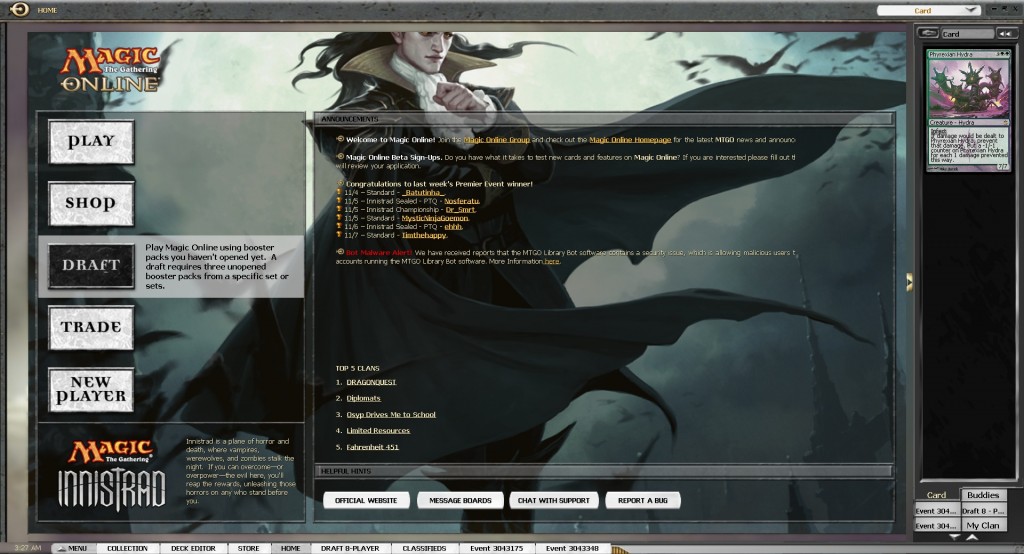
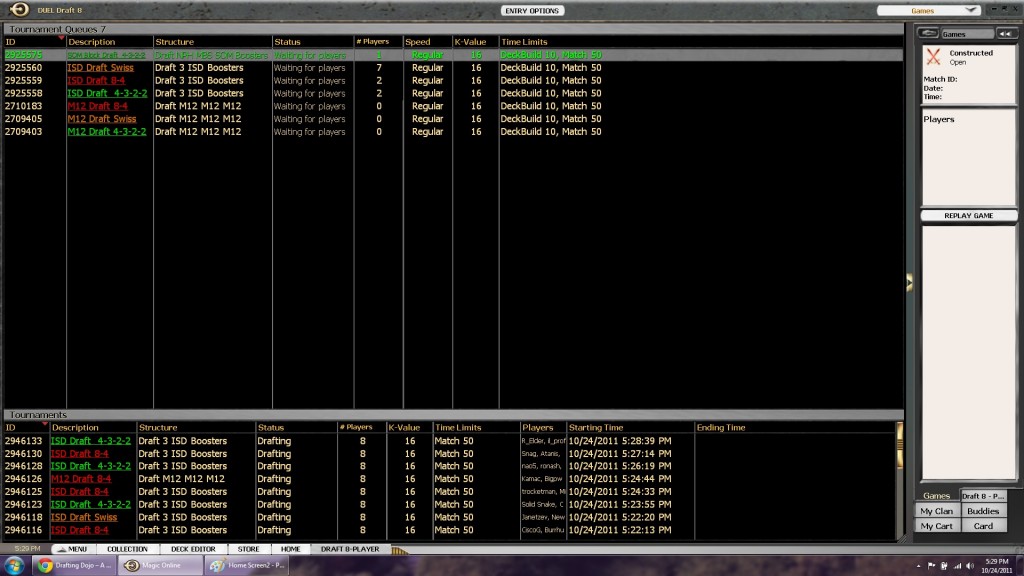
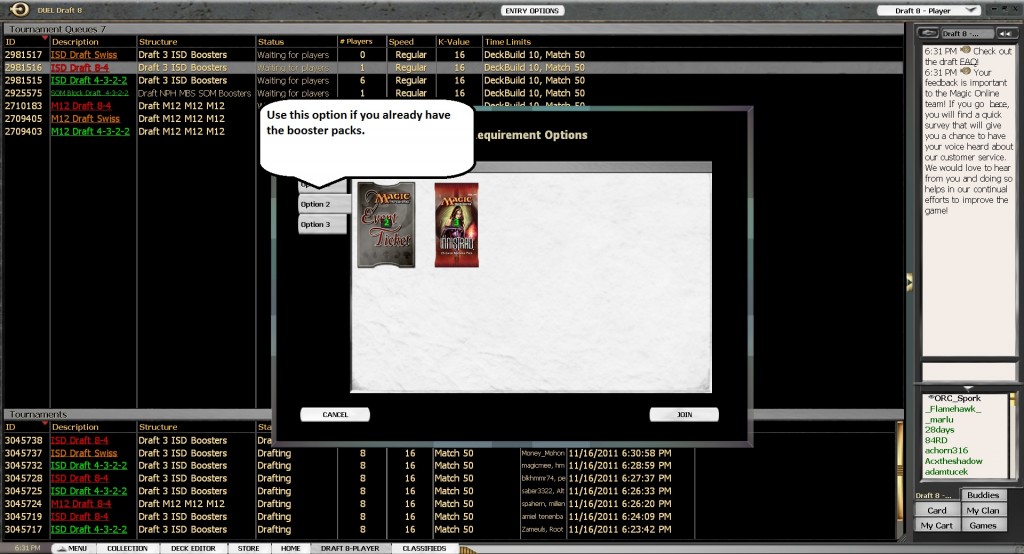
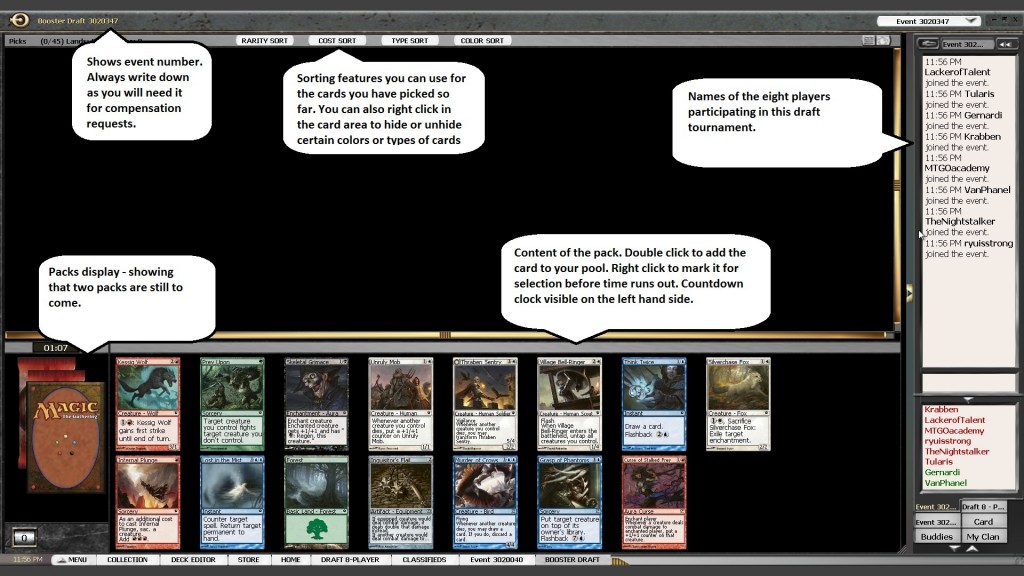
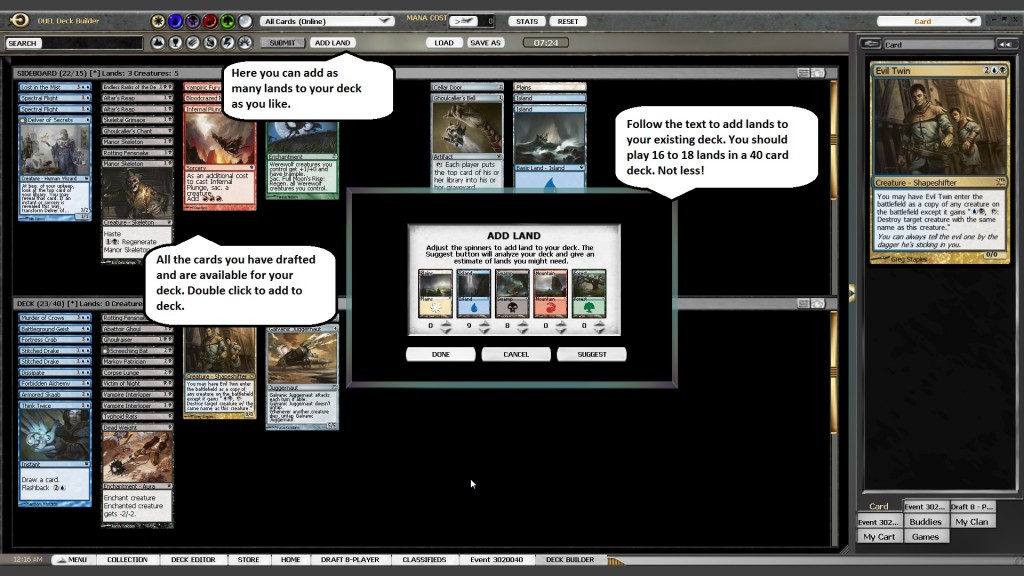
If you have never played Magic Online before:
1) Use “Menu”->”Settings”->”Game Play” to set your turn stops. MTGO will pause the game and ask if you want to do something at each stop, or skip all steps you do not have stops and assume you are not interested in them.
2) Move your arrow over a card and click both buttons at the same time to zoom in to see a card better
3) Hold the control key down when you click a spell if you want to retain priority after that spell is cast (by default, you will pass priority to your opp when you play spells and abilities.)
4) Check out the official WotC MTGO New Player Forum at http://community.wizards.com/go/forum/view/75846/134978/new_player_forum
I think you need to update since they changed the menus for accessing the queues so that now it is all under the limited queues
Updated.
My noob friends thank you! And i thank you too i suppose because it saves me time doing the explaining.
I like this part of mtgoacademy and it is the only site doing this kind of content!
And buy boosters from bots and then pay the 2 ticket entry. Cheaper than the 14 ticket entry fee (can enter a M12 draft for ~11 tix).
When is a good time to start drafting?
I have quite a lot of paper experience, but none with the new cards (played up to ~time spiral), planning on starting anew in the online system.
Also I have no drafting experience.
Great summary!
Be sure to do the “New Player” Phantom Drafts with the New Player tickets that now come with accounts. They are a great and fun way to get in to drafting!
Also, use bots. Never pay $4 per pack. Most currently drafted formats linger between 2.5 and 3.3 tix.
I think it would be very useful if you posted how to save a deck that you created after drafting. I didn’t know how to submit a deck that I built after drafting and had my whole sideboard loaded once the game started. I’m still looking for clear instructions on the process.
Do you keep the cards after a draft like in the paper drafts?